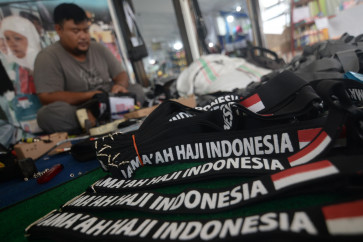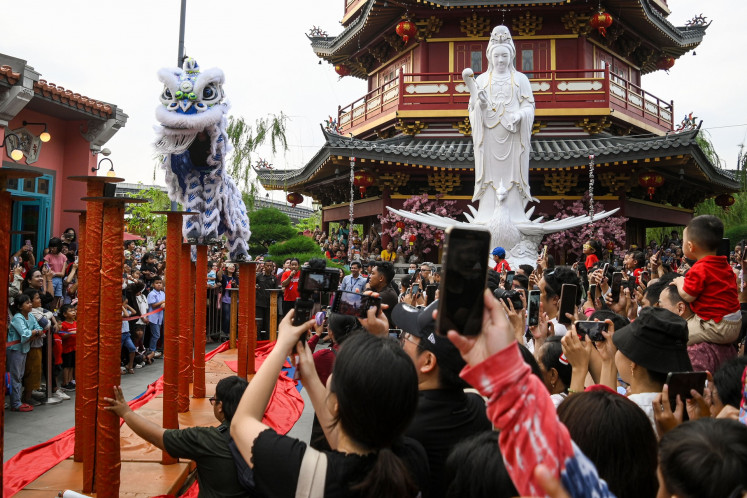Tracking a mysterious artifact in Flores
Jong Dobo, which means the Boat on Dobo Hill, is a mysterious relic that continues to challenge scientific explanation that is on display in Dobo in Sikka regency, Flores
Change text size
Gift Premium Articles
to Anyone

J
ong Dobo, which means the Boat on Dobo Hill, is a mysterious relic that continues to challenge scientific explanation that is on display in Dobo in Sikka regency, Flores.
In the form of a small copper boat 60 centimeters long, 12 centimeters wide and 25 centimeters high, Jong Dobo has 22 figures represented on board, comprising a captain, three helmsmen, 12 oarsmen and six passengers beside a chicken and a gong.
Now under the care of Tana Pu’ang (landlord) Sergius Moa, Jong Dobo is believed by locals to be a sacred object with supernatural powers, capable of producing heat, rain, strong winds and even creating disasters.
The road leading to Jong Dobo’s location is only two and a half meters wide, with cashew and candlenut trees neatly lining both sides. It is 100 meters from the gate of the two-and-a half-hectare Jong Dobo complex to the home of the inheritor and keeper of the miniature boat, Sergius Moa.
“There’s no specific taboo for visitors wishing to see Jong Dobo. But the forest where the Jong Dobo compound is located has a big stone at its gate that nobody is allowed to sit on. None of the trees and plants in the location can be damaged either to avoid disasters. Also, no food is to be brought here,” Sergius said.
Though no further restrictions are imposed, he always reminds visitors of earlier incidents. In 1943, two teachers from Bei in Kangae district borrowed Jong Dobo to show to their students, but three stormy days followed in Dobo and Bei until the boat was returned.
The same happened when Jong Dobo was moved to the Museum of Blikon Blewut Ledalero.
And in 2009 a researcher from Germany, Janina Findeisen, along with Pose Jurgen from Jakarta came to ask for part of Jong Dobo to be taken to Germany to study. “But I didn’t give it to them. When Janina took pictures of it with a digital camera and video recorder, no images appeared. Finally, four months later, Pose Jurgen returned and took photos of Jong Dobo again,” said the bearded Sergius.
He explained that in order to visit the Jong Dobo, a ritual should be observed by giving offerings to ancestral spirits that include rice, salted fishtails, betel leaves, areca nut and tobacco.
“But there’s no requirement. If a guest is unaware of this, I will prep them. This ritual is needed to prevent undesired consequences,” said the man who earns Rp 300,000 (US$31) a month from Sikka’s Tourism Office to maintain Jong Dobo.
“According to legend, Jong Dobo came from the Dongson culture, and set sail from India to find a fertile land to settle. Before putting out to sea, all those aboard had to make a vow not to violate their customary laws, nature and God. If they failed, they would be cursed and become small. They eventually breached the vow and Jong Dobo thus turned into a miniature,” he said.
As for the journey, Sergius said the passengers on Jong Dobo left India for Thailand, the Malacca Strait and Indonesia through Sumatra, Java, Bima and Labuan Bajo in Flores. Cruising along the northern coast of Flores, they stopped in Koli Dobo in Bajawa and proceeded to Ende, then continuing to Maumere and eventually berthing in Waipare in Kangae district.
In Waipare, the ship’s anchor was broken and left behind, forcing the ship’s passengers to continue on their voyage the next day. According to Sergius, the Jong Dobo anchor can still be found on Waipare Beach.
When the passengers arrived at Ihigete Gera in Getung Deu, they were received by an unknown man with a skin disease. Then their boat ran aground and was dragged onto a hill causing Jong Dobo to split into two.
“Unwelcomed by locals, they kept trekking and settled on Dobo Hill. They were received by Moat Wogo Pigang and have since made the place their home,” added Sergius. Moat Wogo Pigang is considered the first inheritor of Jong Dobo and Sergius Moa is the seventh.
Sergius said the Jong Dobo artifact had been studied by historians like Th. Hoeven and Hugh O’Neil, who came to different conclusions. Greek and Latin expert Hoeven said Jong Dobo came from the Dongson culture of the 13th century in Vietnam, whereas O’Neil from Australia saw it as of Sumerian origin from the third century BC.
The conflicting opinions and Dobo folklore mean that up to the present the Jong Dobo relic remains a mystery in terms of where it came from, who brought it to the hamlet and why it was left on Dobo Hill.
Sergius Moa revealed that based on a study conducted in 2004 by Father Eman Embu, he was found to be the seventh inheritor of Jong Dobo.
The first was Moat Wogo Pigang, followed by Moat Bela, Moat Sia, Moat Nong, Moat Potu Mumeng and Moat Domi Hende. Moat Sergius Moa inherited the relic in 2001.
Sadly, however, there are few supporting facilities in the location. There are no homestays or lodging houses even though the Jong Dobo compound is a tourist attraction in Sikka regency.
Sergius, as the present caretaker, hopes the Sikka Tourism Office will build accommodation, public restrooms and other facilities so guests can enjoy their experience visiting Jong Dobo.
“It’s my hope that this place will be better arranged for the greater convenience of visitors so they can enjoy the unique features of Jong Dobo,” he said.









